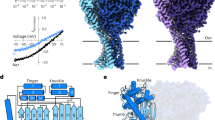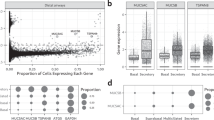Abstract
Rat peritoneal mast cells respond to antigenic stimulation by releasing histamine through exocytosis. The dynamics of exocytosis can be investigated by dialysing single cells with patch pipettes using the whole-cell recording configuration of the patch-clamp technique1,2. However, dialysed cells fail to respond to external stimuli such as compound 48/80 or antigens, suggesting that essential cytoplasmic components have been washed out. We have developed a new patch-clamp configuration in which the patch under the pipette tip is not disrupted but instead permeabilized, preventing the diffusion of large molecules out of the cell. In this configuration the cell responds to external stimulation, and the capacitance as well as the conductance of the cell membrane can be recorded during degranulation. On antigenic stimulation, the cell capacitance (proportional to plasma membrane area), after an initial delay, increases by a factor of about 3. This increase in capacitance is often preceded by a transient increase in conductance. Agents that block Ca-activated channels inhibit this conductance change without affecting the amplitude and time course of degranulation. We therefore conclude that, in contrast to excitable secretory cells such as chromaffin cells2, mast cells do not use ion channels in stimulus-secretion coupling.
This is a preview of subscription content, access via your institution
Access options
Subscribe to this journal
Receive 51 print issues and online access
$199.00 per year
only $3.90 per issue
Buy this article
- Purchase on Springer Link
- Instant access to full article PDF
Prices may be subject to local taxes which are calculated during checkout
Similar content being viewed by others
References
Fernandez, J. M., Neher, E. & Gomperts, B. D. Nature 312, 453–455 (1984).
Neher, E. & Marty, A. Proc. natn. Acad. Sci. U.S.A. 79, 6712–6716 (1982).
Bennet, J. P., Cockcroft, S. & Gomperts, B. D. J. Physiol., Land. 317, 335–345 (1981).
Lindau, M. & Fernandez, J. M. J. gen. Physiol. (submitted).
Hamill, O. P., Marty, A., Neher, E., Sakmann, B. & Sigworth, F. J. Pflügers Arch. ges. Physiol. 391, 85–100 (1981).
Fernandez, J. M., Bezanilla, F. & Taylor, R. E. J. gen. Physiol. 79, 41–67 (1982).
Fishman, M. C. & Spector, I. Proc. natn. Acad. Sci. U.S.A. 78, 5245–5249 (1981).
Hoffman, E. K., Simonsen, L. O. & Lambert, I. H. J. Membrane Biol. 78, 211–222 (1984).
Gomperts, B. D. Nature 306, 64–66 (1983).
Mazurek, N., Schindler, H., Schuerholz, T.H. & Pecht, I. Proc. natn. Acad. Sci. U.S.A. 81, 6841–6845 (1984).
Foreman, J. C., Hallet, M. B. & Mongar, J. I. J. Physiol., Lond. 271, 193–214 (1977).
Foreman, J. C. & Mongar, J. L. J. Physiol., Lond. 224, 753–769 (1972).
Grosman, N. & Diamant, B. Trends Pharmac. Sci. 5, 183–184 (1984).
White, J. R., Ishizaka, T., Ishizaka, K. & Sha'afi, R. Proc. natn. Acad. Sci. U.S.A. 81, 3978–3982 (1984).
Ennis, M., Ind, P. W., Pearce, F. L. & Dollery, C. T. Ag. Actions 13, 144–148 (1983).
Author information
Authors and Affiliations
Rights and permissions
About this article
Cite this article
Lindau, M., Fernandez, J. IgE-mediated degranulation of mast cells does not require opening of ion channels. Nature 319, 150–153 (1986). https://doi.org/10.1038/319150a0
Received:
Accepted:
Issue Date:
DOI: https://doi.org/10.1038/319150a0
This article is cited by
-
Orexin receptors 1 and 2 in serotonergic neurons differentially regulate peripheral glucose metabolism in obesity
Nature Communications (2021)
-
Z f-and-H sys-based C m measurement under the whole-cell patch-clamp recording
Pflügers Archiv - European Journal of Physiology (2009)
-
Ultrasonic bath depth control and regulation in single cell recordings
Pflügers Archiv - European Journal of Physiology (2006)
Comments
By submitting a comment you agree to abide by our Terms and Community Guidelines. If you find something abusive or that does not comply with our terms or guidelines please flag it as inappropriate.



